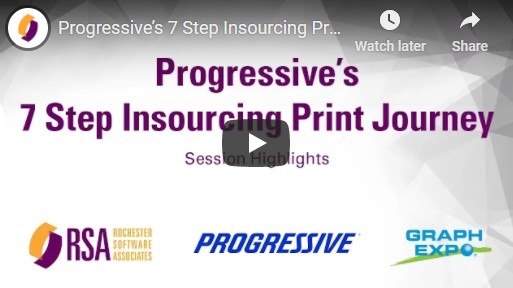- Elisha Kasinskas
- |
- January 10, 2016
At a recent presentation sponsored by Rochester Software Associates, Tom Rohrbach, IT Systems Engineer Consultant at Progressive, shared a 7-step framework that Progressive utilized to determine the optimal balance of in-house and outsourced work for their firm. In addition to the 7-step process, Rorhbach related the key project learnings. Watch the entire 31-minute session video here.
Progressive - an Impressive In-plant
Headquartered in Cleveland, the in-plant has 119 employees in two locations with a $74 million annual budget, producing 225 million impressions annually. While 85 percent of the volumes are from the transactional part of the operation, the in-plant is part of the Creative Business Operation (CBO) team, who is responsible for everything from design through shipping. The CBO "creative" group produces marketing, promotional, advertising and corporate pieces, and the transactional operation supports operational business functions, such as billing and producing policy notices. Rohrbach detailed how work comes into the shop. Jobs come in from a variety of sources and automated feeds from business applications flow through various design tools and postal preparation software, and then through workflow and conversion or processing tools prior to production on the shop's offset, high speed digital (color and monochrome) and finishing and bindery equipment. Post production, jobs are shipped/mailed or warehoused.
Millions of Dollars Spent Externally Put Control Outside
Rohrbach shared that Progressive was sending millions of dollars of creative print work annually --- nearly all of the creative work --- outside the organization for processing and printing. The impetus for the analysis project was cost management. "It came down to cost management." They couldn't be sure that we are being cost effective and had to dig into their data to see what it told them. In addition to understanding if insourcing would improve cost management and job turnaround, the organization also wanted to maintain brand and data control, and enable vendor neutrality. Rohrbach stated "Content ownership has become a real question at Progressive… We need to take that content ownership back. We have the tools in-house to do that. We need to get better at using them."
The 7-Step Process
A thorough analytical 7-step process considered all factors to determine the best balance of internal and external production. The 7 steps in the analysis process included:
1. Define the insourcing opportunity - The organization determined if an opportunity existed and the scale of the opportunity. Rohrbach stated that Progressive utilized shop floor data and kept diving deeper and deeper into the data as questions arose.
2. Establish project mission - Understanding why the business was doing the analysis was important. For Progressive, they established the mission as determining where jobs were produced and why, predicting future customer needs, and making recommendations to maintain, outsource more, or add internal capabilities to reduce costs and impact service levels.
3. Determine the approach - In this part of the process, steps were identified that would answer the questions put forth in the mission.
4. Define current state - Here Progressive defined the capacity and utilization of equipment, including hardware and software, functional and device by device process reviews, and understood the complete flow of projects. For externally produced jobs a review process similar to internal jobs was performed.
5. Internal vs. External Analysis- For each job, they asked if it could be internally produced. If so, would internal capabilities need to be added or modified to produce a job in-house?
6. Project customer needs and volumes - Identify customers, prioritize customers by volume and project type, determine if projects are onetime or ongoing, and identify future project types.
7. Define future state - Progressive is at this stage, determining if procurement of additional or replacement equipment will enable producing outsourced work internally at a better cost with better service. They are also working on refining staffing and cost models in this step of the process.
Key learnings - The Importance of Data and Business Champions
Key learnings for Progressive included: the importance of the data and IT support; the need for business champions to champion the in-plant; and owning the brand.
Projecting the Future from Analysis Findings
According to Rohrbach, the real challenge is using the data from the analysis to project how Progressive's future will look. What the project has really brought about is what Progressive calls "right work, right place" - making sure they are doing the work where it belongs. A project team now looks at every project that comes in and ensures that it is produced where it makes the most sense. Rohrbach noted, "This isn't something you do one time. It's something you need to continue to do over and over again as you work your processes… In-plants face a constant challenge… At Progressive we have to continually prove that our existence is worthwhile. And what we have to offer is speed to market. We offer cost-competitive pricing. We have to continue to provide the business the leverage to provide the best that we can be… We have to challenge ourselves."

Want more insights?
Watch the entire 31-minute session presentation video. This insurance in-plant print center discusses how they balance in-plant and outsourced print.